A Women's Icon
Helena's Commemorative Mural
As Helena’s charming downtown meanders along a slightly crooked path, history speaks at every turn. Among its historical treasures and prominent features is a colorful mural painted on the side of the Livestock Building, where Broadway crosses Last Chance Gulch. The Women’s Commemorative Mural, at the south gateway to the North Walking Mall, is a community landmark. The story of its creation is a tribute not only to pioneer resilience and those who came before us, but to the vision of contemporary women.
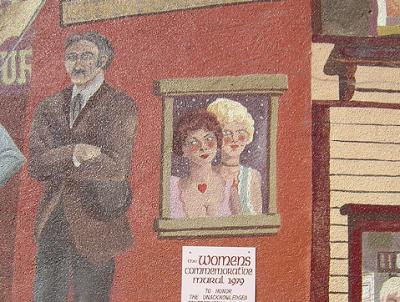
Along with most communities across the nation in the 1970s, Helena underwent extensive urban renewal. Some 235 buildings were razed and traffic discontinued along Last Chance Gulch—the main thoroughfare. Officials created the North and South Walking Malls, dividing the two halves of downtown. On the heels of this monumental change, women of the Helena community planned their contribution.
In 1975, women founded the Helena Women’s Center to address and act upon issues concerning women. This group conceived the idea of a women’s cultural enrichment mural as a way to forge links between older and newer Helena residents, between artists and patrons of the arts, and among diverse age, income, and ethnic groups.
The mural covers 3,000 square feet and took eight months to plan, fundraise, and research. All women were invited to help. Although many contributed to the Women’s Commemorative Mural, its intricate interpretation has been largely forgotten. The design and painting offered life-changing experiences for those involved, and the subject matter continued to evolve throughout the process. The mural is, in many ways, symbolic of the coming together of the community, of fellowship, and of women’s significant contributions.

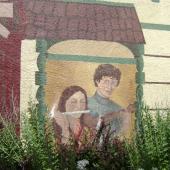


The artistic arrangement consists of three major sections with each section telling multiple stories. An old woman dominates the first section. She represents the true pioneer, reflecting on her life through memories of herself as a little girl, running free in the Prickly Pear Valley, hunting rabbits with a faithful dog at her side. This panel represents time and change in Montana with the clouds reinforcing the importance of memory. The school teacher and the artist with her palette symbolize the many courageous women who came west—leaving homes and family—to bring education, culture, and stability to the remote frontier.
Fannie Sperry Steele, World Bucking Bronco Champion, on her favorite pinto Napoleon, is one of the few distinct characters depicted in the mural. She represents all independent women who followed nontraditional paths and blazed new trails for others. Along with Fannie are several suffragists, wearing their banners of suffrage yellow, who worked tirelessly to win the right to vote and participate. Painted ladies, a fixture in nearly every frontier settlement, are humorously juxtaposed next to the suffragists.
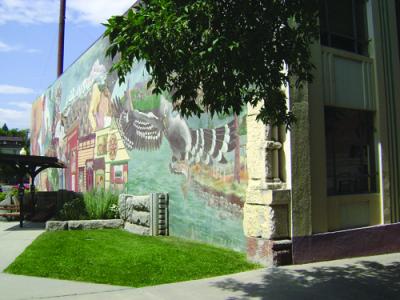
A modern housewife and her beer-drinking, TV-watching husband provide a transition in the second panel. Next door, guitarist M.J. Williams and a fellow musician testify to the talented arts community well established in Helena by 1979. The sleeping mother with her newborn overarches the mural’s center, suggesting new potential wrapped in the quilt of the past. As the mural was being designed, Helena businesswoman Debi Corcran’s son Eli was born. This sparked the inclusion of the quilt as the essence of motherhood, childhood memories, women’s social gatherings, family history, heirlooms, and the importance of handing these things down.
In 1979, a dramatic eclipse of the sun had a profound effect on the community. The artists changed the third panel, dedicated to Native American women, to incorporate the event. This third panel illustrates the pristine, unspoiled wilderness, and beauty of all Montana. It celebrates a way of life that existed in the valley for thousands of years before the arrival of miners and settlers. One way of life eclipsed another, and the Indian woman reflects on her childhood and her ancestors, looking back on a life-way that is no more. The reflections of the pioneer in the first panel and the Native American woman in the final panel connect all women and bring the subject full circle.
Murals like this one are meant to last about 12 years. However, the sense of place the Women’s Commemorative Mural conveys and the public participation that brought it to fruition make it a timeless expression. The mural meant so much to Helena that in 2005 its Public Art Committee refurbished it with Tax Increment Financing (TIF) funds. In this way, it is a living tribute not only to those who have gone before, but to the contemporary community.






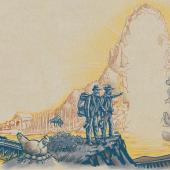
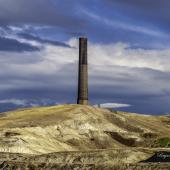
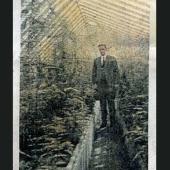

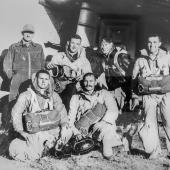

Leave a Comment Here